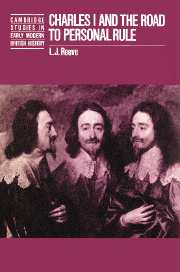Book contents
- Frontmatter
- Contents
- Acknowledgements
- List of abbreviations
- 1 Introduction
- 2 Buckingham's England in crisis
- 3 The death of a Parliament
- 4 The aftermath
- 5 Government and justice
- 6 The king, his court and its enemies
- 7 Foreign policy
- 8 Decision
- 9 The anatomy of a political transition
- Bibliography
- Index
- Cambridge Studies in Early Modern British History
2 - Buckingham's England in crisis
Published online by Cambridge University Press: 13 October 2009
- Frontmatter
- Contents
- Acknowledgements
- List of abbreviations
- 1 Introduction
- 2 Buckingham's England in crisis
- 3 The death of a Parliament
- 4 The aftermath
- 5 Government and justice
- 6 The king, his court and its enemies
- 7 Foreign policy
- 8 Decision
- 9 The anatomy of a political transition
- Bibliography
- Index
- Cambridge Studies in Early Modern British History
Summary
The onset of the Thirty Years War after 1618 destroyed the foreign policy of James I. That policy was very much a product of the king's personality. James was a pacifist who had reacted against the violence of his Scottish background. He was also a lazy man who resented the difficulties posed by conflict and war. In addition he was ambitious. He wished to link his family to the royal line of the Spanish Habsburgs, still the virtual rulers of the world, and he sought to achieve the role of peacemaker in the Europe of his day. On becoming king of England he agreed to end the long Elizabethan war with Spain, and later played an important role in bringing about the twelve years’ Truce of 1609 between Spain and the Dutch. In 1613 the marriage of his daughter Elizabeth to Frederick V, elector Palatine and the leading Calvinist prince of Germany, symbolized his commitment to the Protestant world. His aim was to combine this initiative with the marriage of his son and heir to a Spanish princess and so to fulfil both his diplomatic and dynastic ambitions. When Henry, prince of Wales, died in 1612, negotiations with Spain had come to nothing, and so from 1614 onwards James set about trying to achieve a similar marriage for his younger son Charles. But the king's pan-European diplomacy was dealt a devastating blow by the rash action of his German son-in-law. Against all sound advice, including that of James, in 1619 Frederick accepted the crown of Bohemia in an election disputed by Emperor Ferdinand II.
- Type
- Chapter
- Information
- Charles I and the Road to Personal Rule , pp. 9 - 57Publisher: Cambridge University PressPrint publication year: 1989

